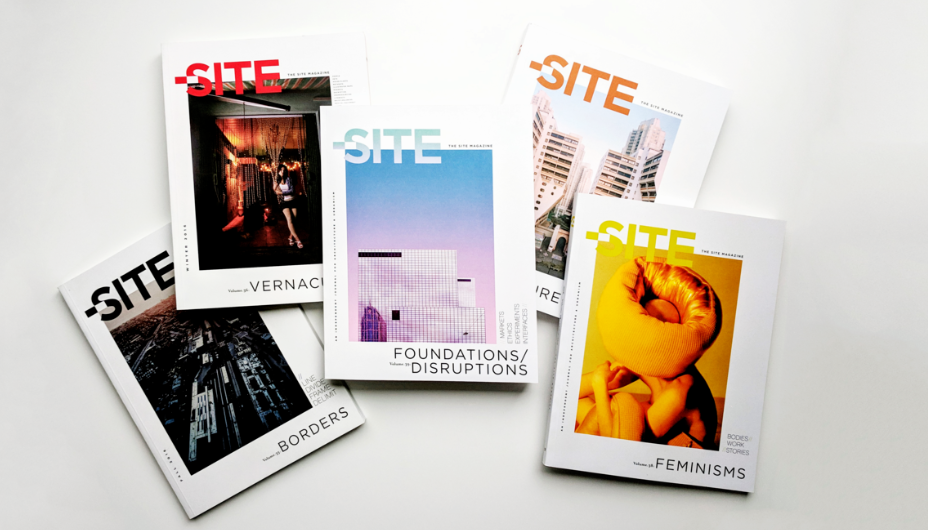How The Site magazine uses a collaborative management structure

Site magazine
Co-editor-in-chief Ruth Jones spoke in Toronto recently, explaining that the magazine’s success lies in collaborative management. The Site magazine has built in time and collaboration into the editorial and production process, allowing the editors to focus their energy on the production of an unconventional, global architecture magazine.
“Collaboration begins with the initial call for papers that helps us frame each issue,” Jones explained. “We have an ongoing editorial agenda to explore topics across disciplines (architecture, landscape, urbanism, and design) and formats, so we have a collective discussion about the place of each call in our larger project. We’ll talk through how the theme fits with our individual interests and who has contacts that might work for solicitations, and take stock of how we’ll bring Canadian and global perspectives to bear on the issue’s theme.”
Right now, The Site Magazine has three co-editors in chief: Jones, Aisling O’Carroll, and Miriam Ho. Carey van der Zalm, The Site Magazine’s creative director, works with editorial conceptually on each issue as well as managing the publication’s visual identity overall. Nicole Bruun-Meyer is the head of communications and partnerships, and Michael Taylor manages fundraising for operations and special projects.
An amalgam of Field Notes Press and On Site review, The Site magazine is wholly volunteer-run. The fact that the magazine’s management are volunteers make them more independent, but also more vulnerable to burnout and demands on their time.
“Changing editorial leads from issue to issue allows the editor heading the project the space to develop her thinking on the questions being raised,” Jones said. “It allows us to rotate administrative and managing editor duties to prevent burnout, and it shares skills among team members that would otherwise be sequestered by our area code.”
Each issue has an editorial lead and that person is responsible for making sure there are features that anchor the theme, while others manage the rest of the operation. The editorial team of Jones, O’Carroll and Ho manage the content of each issue, soliciting pieces, managing contributors, and curating an ongoing editorial agenda, Jones explained.
The Site Magazine publishes six volumes over a three-year editorial cycle. The whole team helps out, and Jones said they try to be flexible about how much each person takes on – there’s no fixed schedule. “Since we only come out twice a year our editorial cycles are long – six months per issue, with overlap at the beginning and end of the process as we lay the groundwork for what’s coming next,” she said.
Collaboration in the publication’s management structure even changes how content comes together for each issue.
“For every issue there are a few articles that feel like personal editorial projects, and these come from intense collaboration between an editor who understands the macro vision for the issue and a writer whose project benefits from an amount of attention that often surprises our contributors,” Jones said. “It also means that when we turn our attention on a subject, we’re able to draw on the knowledge of a particular editorial lead to get us going – our Vernaculars issue wouldn’t have had the depth to say something new if Miriam hadn’t been the one directing the content, which in turn challenged the rest of us to think more creatively about the possibilities for that issue.”
It has also enabled Jones and her co-editors to pursue other projects like exhibitions that complement and grow the magazine’s content, and make The Site more than just a magazine.
Collaborative structures work for The Site magazine because of a shared belief that the magazine and associated projects work better because they’re all in this together, Jones explained.
“I think this kind of horizontal arrangement generally works better at smaller operations, but I don’t think it’s impossible to replicate,” Jones said. “We have a strong sense of shared vision – we have similar ideas of what we want a magazine to be, and what we saw missing from the architectural publishing landscape in Canada when we started. We’ve definitely benefited from doing things differently – winning Best Magazine at the National Magazine Awards this year is proof of that – and publishing in general needs new models to meet the challenges of today’s market.”
Lessons
The Site magazine’s volunteer staff is based in cities around the world. Collaboration is what makes the magazine successful, despite distances and time zones.
Jones suggests for other publishers looking to incorporate collaboration into their processes, to never stop talking about what your goals are – as individuals and as an organization, she said.
“Keep lines of communication open, and keep tabs on investment and wellbeing,” she said. “When roles are flexible, it’s important to make sure the less glamorous and exciting work is also getting done and that no one person is taking on too much. That said, the biggest benefit to being part of a successful collaborative project is that you have confidence in your team – when you can trust your collective commitment and skills, you end up spending more time talking about ideas and less time managing logistics.”
More like this
NYMag’s The Strategist launches SoHo pop-up shop for holidays
Leading journalism academics discuss age of misinformation
How Smithsonian magazine leverages live events across platforms
Departures magazine debuts new interactive print ad in partnership with Audi
How Vivendi’s video platform Dailymotion’s hyper-personalisation spurred audience growth


![[New!] FIPP Global AI in Media Tracker – November 2025](https://www.fipp.com/wp-content/uploads/2025/06/articles-header-800x760.png)





